
Get to know - Italian bug. According to the scientific classification, where the Latin terminology is adopted, this insect is called Graphosoma italicum. People who saw him in their own garden thought up various pleasant and not very nicknames for him: tiger-bug, or simpler, bug-whaling.
The genus Grafosomy has only a few species, two of which (Shchytnik ruled and Shchytnik Italian) are so similar to each other that even entomologists argue whether to classify them to different species or to distinguish two subspecies in one species. Try to figure out whose photo is in front of you:
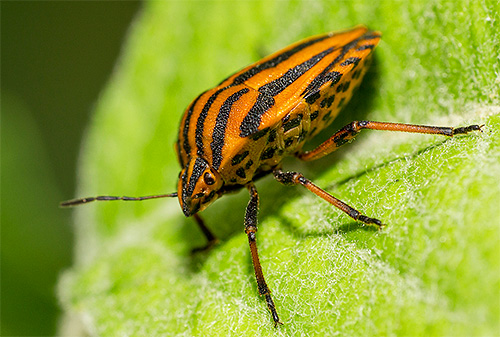
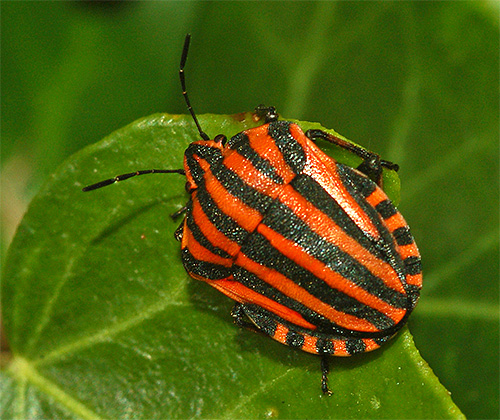
Determine this power, perhaps, only serious professionals. It is believed that the color of the Italian bug is red-orange rather than orange, as in the subspecies Graphosoma lineatum lineatum, and its legs are black with splashes of red, and not black-red or orange.That's all that helps to recognize who is who.
Habitat Italian bug
Italian bug is spread quite widely. It is a heat-loving insect, but is found not only in the southern and central regions of Europe. It is well adapted to the climatic conditions of central Russia.

Italian bugs have long been not uncommon also for Siberian gardens, grasses of meadows, farmland and forest edges, wherever umbrella trees grow. A few years ago, Ukrainians were surprised and alarmed by the incredible increase in the number of Italian bugs, these beautiful insects.
The appearance of the bug
The Italian bug has everything that the Real Shivnik should be. The main attribute of the representatives of the family Pentatomidae is the shield. The medium chest of bugs is a dense chitinous plate, shaped like a shield. It plays the role of an exoskeleton, protects vulnerable parts of the body of the insect: the belly, wings, internal organs.
The graphosome shield lies with a broad base forward, and slightly narrowed behind, and leaves a small part of the abdomen uncovered. Pay attention to the following photo:
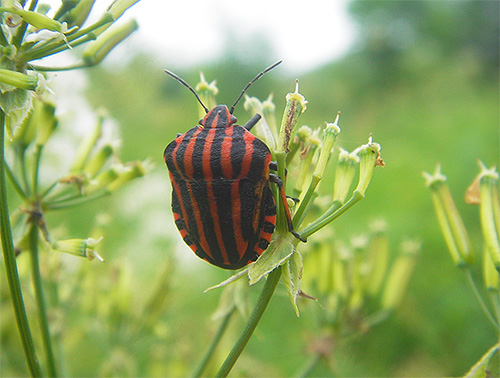
The bug of the Italian really deserves admiring glances.It is of amazing red-orange color, with six longitudinal black stripes visible from above, and black spots from below, the number and location of which can vary.
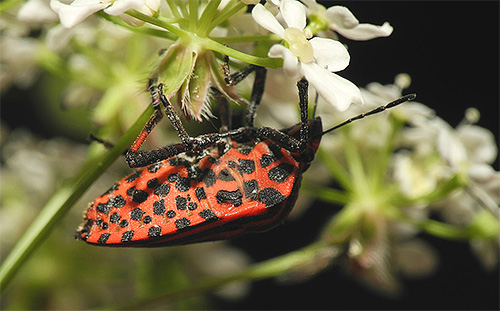
It occurred to someone that a similar combination of colors (red-orange color with dark stripes) can be seen on the uniform of the guardsmen guarding the residence of the head of Catholicism - the Vatican. Therefore, some, albeit indirectly, related to the Italian terrain, the bug still has.

His bold warning color draws attention to himself and gardeners, anxiously guarding their crops, and potential enemies - birds and photographers. Such a notable copy asks for the lens:
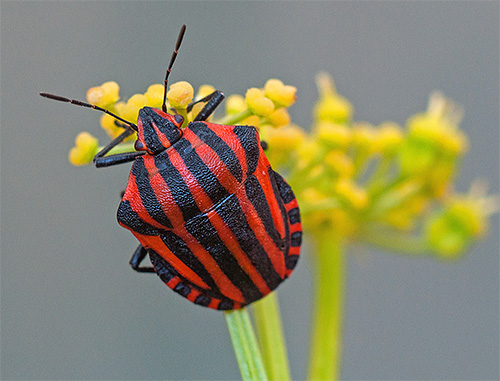
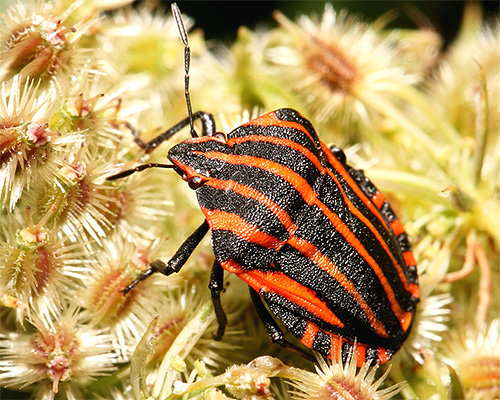
Did you know that ...
Warning coloring is used intentionally by insects. It protects the owner from natural enemies. It turns out that you can be safe without hiding, but deliberately exposing yourself. As a rule, those creatures that possess any means of protection look defiant. So bedbugs have a very unpleasant smell, and they are inedible. The bird will not touch such an insect, and the spider will hasten to get rid of the prey accidentally caught in its web.
The head of the Italian bug is triangular in shape, hidden to the eyes under the pronotum. An insect, like antennas, sets forth two antennae, consisting of five segments. This is his sensitive organ. The oral apparatus of the sucking-type bug is a proboscis, also having a segmented structure. This insect feeds exclusively on plant sap.
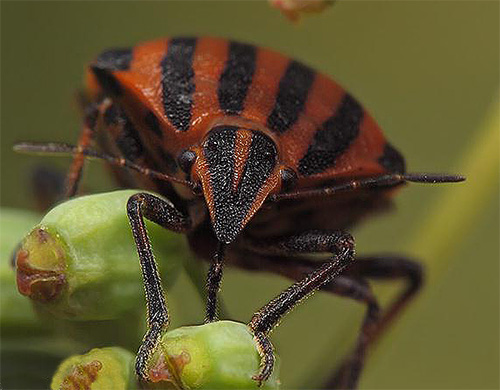
Two pairs of wings of the Italian bug are packed under the shield. The front fenders are represented by leathery and webbed sections, with the longitudinal folds highlighted on the latter. The rear wings are entirely webbed, and they keep the bug in the air.
In sunny weather, some people manage to meet with the Italian bug, flying from one plant to another. But, if someone is disturbed by an insect sitting peacefully on a leaf, it will not hasten to fly away from the chosen place. Most likely, the graphosome will simply fall to the ground or even allow itself to be grabbed. But the offender may have no doubt, the bug will use its secret weapon: it will release an odorous liquid.

Italian bugs move through the stems and leaves thanks to three pairs of tenacious legs, it is easily held on plants swayed by the wind.
Breeding features
The Italian bug, like all Hemiptera, in its development passes through three stages: the egg, the nymph, the imago.

After wintering in a soft bed of fallen leaves, the adult bug gets on the wing and goes in search of food.
When it is warm enough outside (it usually happens in May), mating occurs in Italian bugs. At this time, they gather in fairly large groups, actively feed, but here on the foliage and green shoots of plants, not particularly bothering to search for secluded places, the fertilized females lay eggs. Laying bug bug is easy to recognize. The eggs are laid in a strict order: in two rows of six pieces.
They are like miniature kegs firmly attached to a plant. At one end there is a cap from which a larva emerges, resembling the outlines of a mature Italian bug, but excellent in color.
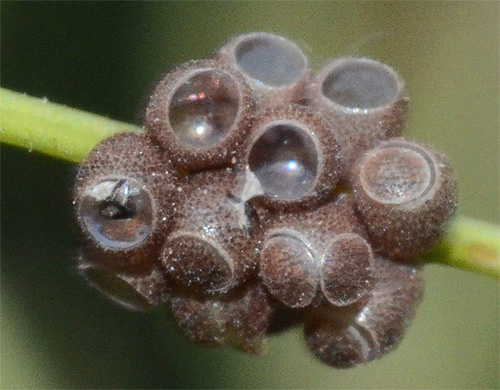
The rate of maturation of the embryo in the egg is directly dependent on the ambient temperature. The warmer, the faster the ripening. In hot climates, nymphs appear after only 6 days; in cooler conditions, this process drags on for up to a month.
The same can be said about the larvae of the Italian bug.In areas with a temperate climate, they reach sexual maturity within 25-30 days, and in the south the process is accelerated twice. During the summer, 2-3 generations of striped shieldlings have time to grow.
Is it worth fighting with the Italian bug?
The favorite delicacy of the Italian bug is the juices of the umbrella family plants.. He is especially attracted to seeds. The owners of homestead plots, for sure, have seen the striped bug bugging dill, parsley, carrots, or the ever-present slyt.
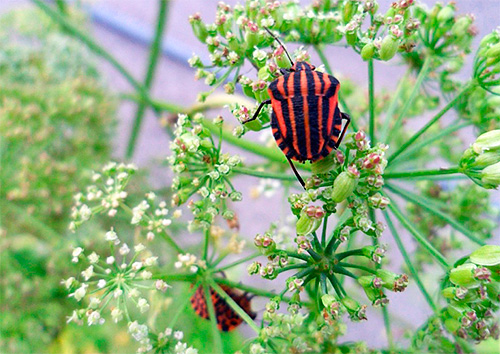
The question of whether the appearance of a bedbug, called Italian, is dangerous is debated. Someone considers this insect pest, which must be mercilessly fought. Seeds, damaged by the bug, dry up, crumble before the deadline, and they are never destined to sprout. But other people do not see any problem in the fact that the graphosome settled in their gardens. It is believed that she is very careful with the seeds, without affecting their germination.
Where is the truth? Do you take action against the Italian bug? Let's reason sensibly. Not many gardeners are engaged in independent growing of umbrella seeds, and the bug does not cause any damage to the plants themselves,Yes, and several individuals are not able to deliver a significant blow to the harvest. First of all, it is worth getting rid of sleep, so as not to tempt.
If the number of shchitnikov reached frightening sizes, and insects, like necklaces, hung on the bushes, and the fate of the planting material of the owners is very disturbing, it makes sense to deal with the pest mechanically.
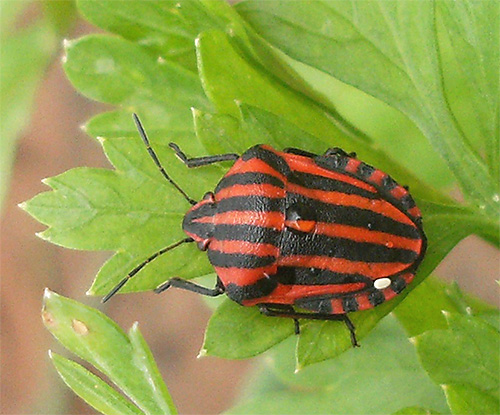
The Italian bug is not shy, in its bright uniform it is easily distinguishable against the background of lush greenery, and it will be easy to assemble it manually during mating. And only in exceptional cases may need the help of insecticides. And here it is necessary to correctly approach the choice of the chemical, without harming the beneficial insects and, therefore, the future harvest.
Interesting video: Italian bug

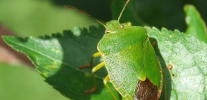
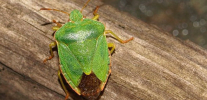

Nowhere is there information on the fight against the Italian bug of chemicals